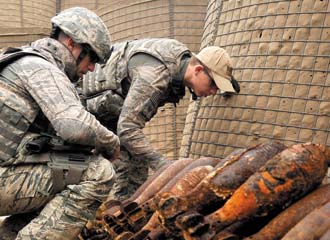Neutralizing the Network to Defeat IEDs
 |
Two U.S. Air Force explosive ordnance disposal technicians prepare a stack of explosives prior to a controlled detonation at Mahmudiyah, Iraq. The use of improvised explosive devices (IEDs) has declined in Iraq, but the Joint IED Defeat Organization (JIEDDO) continues to race against insurgents seeking to exploit new capabilities. |
The key to defeating improvised explosive devices may lie in attacking the network that procures, develops and emplaces the weaponry rather than focusing on the device itself. Eight years of combating both the devices and their effects has broadened the mission of those tasked with rendering these weapons null in the realm of asymmetric warfare.
Leaders at the Joint Improvised Explosive Device Defeat Organization (JIEDDO) are focusing on the network as part of a multifaceted approach to combating improvised explosive devices (IEDs). The organization continues to strive for technological remedies for detecting or stopping IEDs, and it even is using dogs effectively to sniff out buried booby traps. It also maintains a range of training disciplines geared toward enhancing warfighter survivability in an IED environment.
And, this fight is not limited to the Southwest Asia battlegrounds of Iraq and Afghanistan. On average, more than 260 IEDs are deployed outside of that region each month—about nine per day. The global nature of IED use has JIEDDO in constant contact with all of the U.S. combatant commands. Any one of these commands could be the focal point of the next fight, and JIEDDO must ensure that it is prepared to fight IEDs if necessary.
To win the counter-IED fight now, JIEDDO is taking aim at the IED network—not the technological network, but the human one that is responsible for conceiving and making real the threat. This focus represents a holistic approach that evolved from the organization’s early taskings as a battlefield response group.
JIEDDO was formed in late 2003 as the U.S. Army IED Task Force. After evolutionary changes, by 2006 it had become a formal organization. Command Sgt. Maj. Todd Burnett, USA, is the senior enlisted adviser to the director of JIEDDO. He explains that JIEDDO originally focused on defeating the device itself, and then the organization moved into training. Now, however, the IED network is the main target, he states.
“You want to bring everything you have to bear to attack the network,” Sgt. Maj. Burnett says. “That starts with the person who is financing it, the people who are building it and the people who are placing it. We’re trying to find out where all that resides.
“Nine times out of 10, when we get to an IED emplacer, he turns out to be very low-hanging fruit,” the sergeant major continues. “We want to try to trace [the IED] back to where it’s being assembled and back to the person who’s financing it, because then we can get to the root of the problem. If you just take out an emplacer, there’s another emplacer—they’re a dime a dozen. They’re just somebody who gets an amount of money to go out and emplace the IED.”
So, JIEDDO is looking for the person who has decided to become a deadly insurgent. Whatever cause is driving that person, the result is that the individual’s purse strings are loosened to finance IED operations. Sgt. Maj. Burnett allows that some of these people might be local while others might be based in another country.
A veteran of Southwest Asia operations, the sergeant major notes that Iraq featured Sunni, Shia, Kurd and foreign fighters. Afghanistan did not feature many outsiders; but the country is divided among many tribal units, and conflicts tend to be localized. While the cultural environments in the two countries are vastly different, many similarities emerge among the two.
He explains that the nature of IEDs has changed from one country to another. In the beginning, Iraqi IEDs largely were old rounds that were converted to explosive devices. Then, Iraqi adversaries began to use explosive form penetrators, both copper and alloy. Afghanistan IEDs tend to be homemade explosives, basically a fertilizer mixture that has explosive properties.
In Iraq, the counter-IED fight has improved for U.S. forces, Sgt. Maj. Burnett says. The number of IEDs employed in Iraq has dropped substantially from a high of about 3,500 a month during 2006. The explosive form penetrator remains a dangerous device, but new technologies have blunted its effect. U.S. forces there and in Afghanistan definitely believe that they are winning the battle against IEDs, he declares.
Afghanistan also has seen a downward trend. While some people credit this to the onset of the harsh Afghan winter, the sergeant major points out that the force surge has helped both establish a stronger U.S. presence and provide information valuable in the counter-IED fight.
“We are going to monitor which technologies are working, and we’re going to look for ways to double down on those technologies,” Sgt. Maj. Burnett states.
 |
A U.S. Army soldier in Afghanistan stands watch as an IED is destroyed in a controlled explosion behind him. The IED threat in Afghanistan differs from the one faced in Iraq, and JIEDDO is examining new technologies and capabilities to bring to bear on the battlefield. |
The new focus on the IED network does not indicate a move away from countering the weapons’ technology. “We have harvested a good amount of the low-hanging fruit when it comes to defeating the device,” Sgt. Maj. Burnett offers. “Now, we’re working on some of the higher-end aspects to reach the next level of defeating the device.
“We’re going to continue to refine what we’ve got and make it better as we go, and we’re always looking for good technologies,” he emphasizes.
In 2010, JIEDDO committed $1.25 billion to develop and deliver 22 counter-IED enablers. Yet Sgt. Maj. Burnett emphasizes that JIEDDO is not looking for a 95-100 percent solution. “If you can get a 50-60 percent solution into the hands of the soldiers, it’s not always going to be right but it’s going to save lives,” he states. “We’re an organization that is trying to get solutions rapidly to warfighters, so we’re looking to get the 50 percent solution an operational assessment so that we can get it rapidly into their hands.”
And, training continues to serve a vital role. “Our biggest return on investment is a trained soldier,” the sergeant major declares. “It’s very hard to measure training, but we do know that a well-trained soldier is the one who is finding most of the IEDs out on the battlefield. We’re constantly pulling all of the latest TTPs [tactics, techniques and procedures] and infusing them into the training centers and the home station training capability lanes.”
The organization is delivering 11 new mobile counter-IED trainers, designed specifically for IED simulation training, to five military organizations this spring. These trainers can emulate the physical characteristics of IEDs in a tactical environment through interactive simulation. A variety of complex attack scenarios focuses on understanding IED components and function, appropriate countering procedures and environmental features used to disguise explosives.
Sgt. Maj. Burnett relates that JIEDDO discovered a training gap, so it built 57 new lanes throughout the services that it is trying to infuse in predeployment. This training is updated regularly from touchpoints in theater. Warfighters have the same technologies and capabilities in their home stations prior to deployment, which is important because it is difficult to move assets around in Afghanistan, he notes. That movement was easier in Iraq because U.S. forces had more major forward operating bases (FOBs), but Afghanistan does not have nearly as many FOBs, he adds.
While the organization is focusing on Iraq and Afghanistan, it is not overlooking other IED venues. With nearly 300 IED events outside of Southwest Asia every month, JIEDDO is keeping up with these other uses. Sgt. Maj. Burnett relates that Mexico recently experienced a spike in vehicle-borne IEDs, and Colombia also has had its share. Both may be a result of drug cartel activity in this hemisphere, he observes. Other countries such as the Philippines and Somalia are stricken with IED users, and the sergeant major says that every U.S. combatant command has IED activity in its area of responsibility.
On the intelligence front, JIEDDO has its own organization that focuses on IED intelligence. It has personnel in both Afghanistan and Iraq as well as in every combatant command, and it works interagency with other organizations. The JIEDDO intelligence organization has touchpoints in each group along with reachback in the United States. It constantly fuses information for distribution among its partners and its customer base. This organization also contributes significantly to predeployment training of U.S. military units.
At this point in the counter-IED fight, JIEDDO has two big technological challenges. The first is to find small amounts of homemade explosives or precursors. “Many things come together to make a bomb, so we’re looking at technologies to find IEDs in a form prior to their being a bomb,” Sgt. Maj. Burnett allows. To address this need, JIEDDO is looking at different sensor suites and platforms.
The second challenge is to locate emplaced IEDs. Sgt. Maj. Burnett explains that the majority of IEDs in Afghanistan are buried in the ground, unlike in Iraq where many were laid on the surface. JIEDDO constantly is seeking new technology that can peer into the ground and find emplaced IEDs before they explode. One growing trend is the use of buried low-metal-content IEDs, which are more difficult to detect.
Part of this counter-IED effort may involve moving sensors among different platforms. JIEDDO is looking at different sensors and where they can be most effective. The organization has seen considerable success with vehicle-mounted and dismounted ground-penetrating radar systems, the sergeant major reports.
And, a four-legged organic solution is proving highly successful. JIEDDO has found that dogs can be trained to sniff out buried IEDs, and U.S. forces in Afghanistan have requested more canine IED detectors. They have proved particularly successful with the Marines in southern Afghanistan, he notes.
From industry, JIEDDO needs counter-IED solutions that can be fielded within 18-24 months. “When someone from private industry comes up, we don’t shrug him off; we take a deep dive into everything with all of our specialists from the different areas within JIEDDO,” Sgt. Maj. Burnett says.
Key technologies include those that can find command wires in urban and rural terrain amid clutter such as trash, rocks, trees and bushes. For airborne platforms, the organization wants new sensors for unmanned aerial vehicles.
Another vital need is the ability for standoff detection of IEDs and their components. JIEDDO officials admit that this is a difficult task, especially given the laws of physics, but the potential payoff is huge.
And, to defeat the network, JIEDDO needs tools for understanding social networks as it targets, attacks and disrupts them.
For JIEDDO, success may bring shrinkage. Sgt. Maj. Burnett offers that, in five years, JIEDDO may be a much smaller organization. While it still will be focused on IEDs, it will have honed its activities to the point where it will have IEDs more under control. Its focus on that area will be more specific, so it would be able to downsize. Currently, according to JIEDDO officials, the organization is challenged to fill its military personnel billets, although it is making great strides to fill its government civilian billets.
WEB RESOURCE
Joint IED Defeat Organization: https://www.jieddo.dod.mil/index.aspx




Comments